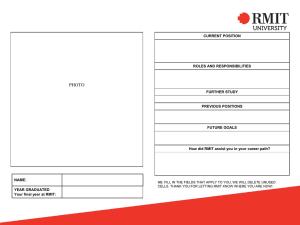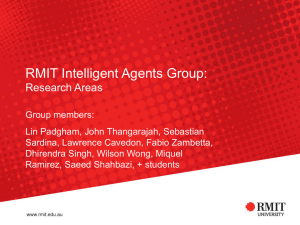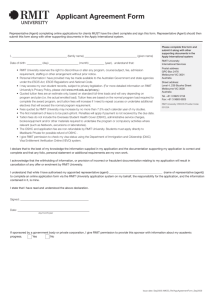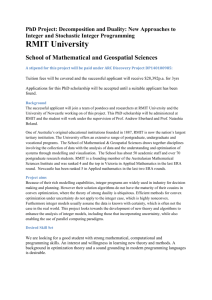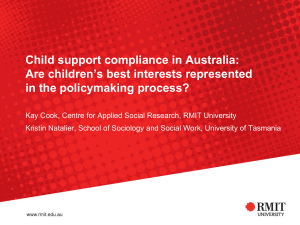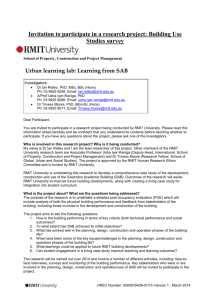Entry Form eResearch Australasia 2009 Visualization
advertisement
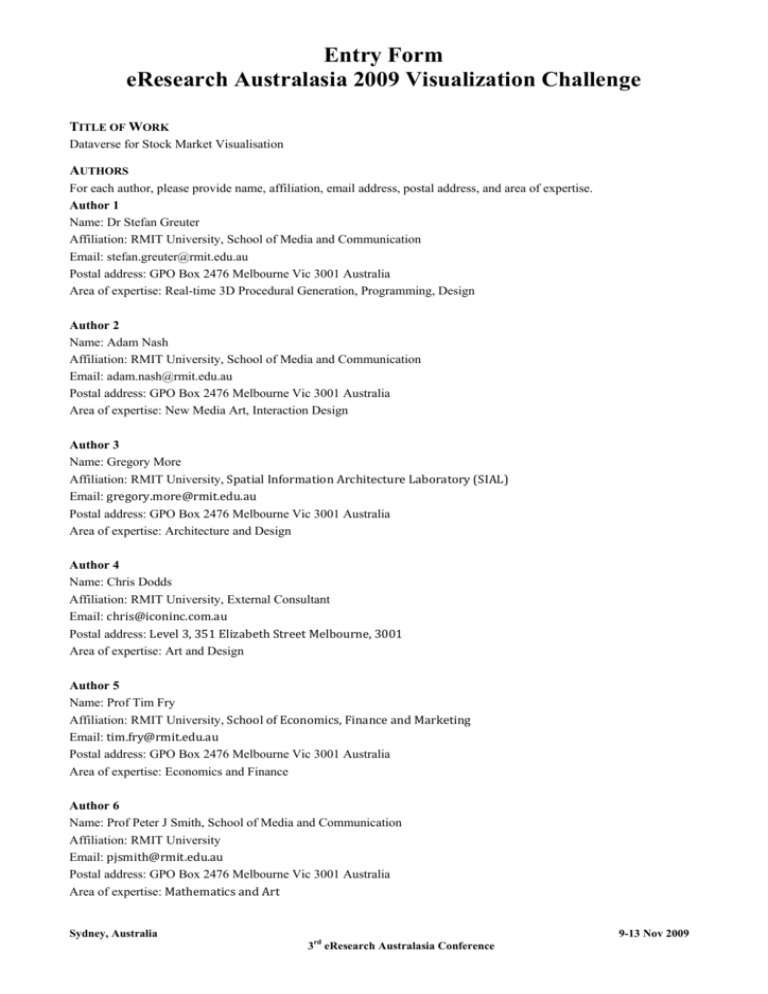
Entry Form eResearch Australasia 2009 Visualization Challenge TITLE OF WORK Dataverse for Stock Market Visualisation AUTHORS For each author, please provide name, affiliation, email address, postal address, and area of expertise. Author 1 Name: Dr Stefan Greuter Affiliation: RMIT University, School of Media and Communication Email: stefan.greuter@rmit.edu.au Postal address: GPO Box 2476 Melbourne Vic 3001 Australia Area of expertise: Real-time 3D Procedural Generation, Programming, Design Author 2 Name: Adam Nash Affiliation: RMIT University, School of Media and Communication Email: adam.nash@rmit.edu.au Postal address: GPO Box 2476 Melbourne Vic 3001 Australia Area of expertise: New Media Art, Interaction Design Author 3 Name: Gregory More Affiliation: RMIT University, Spatial Information Architecture Laboratory (SIAL) Email: gregory.more@rmit.edu.au Postal address: GPO Box 2476 Melbourne Vic 3001 Australia Area of expertise: Architecture and Design Author 4 Name: Chris Dodds Affiliation: RMIT University, External Consultant Email: chris@iconinc.com.au Postal address: Level 3, 351 Elizabeth Street Melbourne, 3001 Area of expertise: Art and Design Author 5 Name: Prof Tim Fry Affiliation: RMIT University, School of Economics, Finance and Marketing Email: tim.fry@rmit.edu.au Postal address: GPO Box 2476 Melbourne Vic 3001 Australia Area of expertise: Economics and Finance Author 6 Name: Prof Peter J Smith, School of Media and Communication Affiliation: RMIT University Email: pjsmith@rmit.edu.au Postal address: GPO Box 2476 Melbourne Vic 3001 Australia Area of expertise: Mathematics and Art Sydney, Australia 9-13 Nov 2009 3rd eResearch Australasia Conference Author 7 Name: Jesse Archer Affiliation: RMIT University, School of Computer Science and IT Email: jesse.archer@rmit.edu.au Postal address: GPO Box 2476 Melbourne Vic 3001 Australia Area of expertise: Software Development Author 8 Name: Minh Phuong Doan Affiliation: RMIT University, School of Economics, Finance and Marketing Email: e73040@ems.rmit.edu.au Postal address: GPO Box 2476 Melbourne Vic 3001 Australia Area of expertise: Software Development COPYRIGHT HOLDER Dr Stefan Greuter DESCRIPTION OF WORK Dataverse is a real-time 3D visualisation framework. The framework was developed to generate real‐time 3D audio visual environments from arbitrary sets of statistical data for the purpose of data visualisation, composition and live audio visual performance. This particular version of Dataverse is optimised for stock market visualisation in real-time. In this project, we investigated the stock performance of the 30 largest and most widely held public companies, which make up the Dow Jones Average, relative to the performance of the U.S stock market. The data contains the largest stocks that cover major sectors of the U.S economy: Consumer Discretionary, Consumer Staples, Energy, Financials, Industrials, Information Technology, Health Care, Materials, Telecommunications and Utilities. The data was collected daily spanning the period from 28th September 2008 to 24th September 2009 (approximately 8000 observations). We implemented the Ordinary Least Squares (OLS) regression technique to analyse the performance of stock returns in relation to the performance of the market. The slope of the regression line tells us how many the stock return changes given a unit change in market returns. The residual is the difference between the actual value of stock returns and the predicted CAPM value. The residual scatter plot is an indicator of the goodness of fit of the CAPM model. It is expected that the residuals scatter around the x-axis. The visualisation is vector graphics based and uses textures and transparency effects. In comparison to the commonly used two-dimensional visualisation techniques, Dataverse maps the stock market data according to their date on the zaxis. The mapping of the x- and y-axis, however correlates to the usual mapping for the two-dimensional visualisation methods for Linear Regression, Residual and Residual2. Subsequently, the x-axis always shows the market return of the investigated protfolio for all three visualisation methods. The y-axis shows the position of the company return for the visualisation of the Linear Regression and uses a three-dimensional plane for the linear regression model. The visualisaion of Residual maps plots the difference between company return and the related point on the linear regression line on the y-axis and uses the square of this value for the Residual2 visualisation. In order to maximise performance, Dataverse was programmed in C++ and OpenGL. The software uses a scene graph structure and a vertex buffer objects to allow the software to run on mid-range graphics and gaming workstations. The examined period covers the period of the global financial crisis and is clearly evident in the dynamic movements of stock returns visualized in Dataverse. In comparison to the usual two-dimensional visualisation methods, Datverse shows how stocks performs through time and the point and click interface makes it very easy to spot points that show abnormal performances and receive detailed information in the top left hand corner. This information is helpful to relate other information to the market in order to explain the cause of the abnormal performance. Sydney, Australia 9-13 Nov 2009 3rd eResearch Australasia Conference SCIENTIFIC AND/OR COMMERCIAL VALUE Statisticians often analyse markets using two-dimensional tools and static data. Dataverse allows users to visualise stock data in a 3D real-time environment and provides statistical analysis tools such as Linear Regression, Residual and Residual Square suitable for non professionals. The application is currently able to evaluate and visualise large datasets in real-time 3D. The tool has got potential for comercialisation as it is of equal interest to professionals and the general public. The software's game engine inspired navigation model provides an intuitive way to explore the whole market or certain stock specific details at close range and from different angles that is not only informative but also fun. However, in order to fully commercialise this tool, it nees further development to support live data, more analysis tools and mechanisms to highlight portfolio constructions, to suit client requirments. From a scientific point of view the visualisation could be enhanced by the real‐time generation of audio signals that are connected to the visual interpretation of stock data and can serve as a base that allows more research in the area of human‐centred interface design and addresses the key research questions of Emergent Environments and Auditory Spatial Intelligence. EDUCATIONAL VALUE (STEFAN) The research team consisted of an exciting combination of of experienced researchers in spatial architecture, real-time art, interface design, technical design, software development, statistical data analysis and econometrics together in order to build the Dataverse project. From an educational point of view it allowed us to build a close research relationship with an interdisciplinary team spread across three centre's of knowledge at RMIT University: Media and Communication, Computer Science and Business. The software framework that was developed as part of this research project may also be used as an educational tool to visualise many other different sources of data and may be adapted to produce many other models for visualisation. Finally, unfolding the relationships between the stock returns and both the market returns and the time-information frame simultaneously has valuable contributions in both academic and practical terms. LINK TO THE WORK Please provide a link to the work. If it is protected, please provide the credentials needed to access it. The link to the project's website is: www.games.rmit.edu.au/dataverse/ The file should conform to the following specifications. Images must be 300 dpi or higher. Image(s) Video and Animation Minimum A4 size 352 x 240 pixels Maximum A2 size 720 x 480 pixels File type TIFF Quicktime (.mov) LINKS TO RELATED PROJECTS OR WORKS You may provide references or related links if relevant. PERMISSION TO DISPLAY AND DISTRIBUTE By entering the eResearch Australasia 2009 Visualization Challenge, you are granting permission to display the work at the eResearch Australasia 2009 Conference and for the competition sponsors to distribute the work online and via DVD. Sydney, Australia 9-13 Nov 2009 3rd eResearch Australasia Conference
